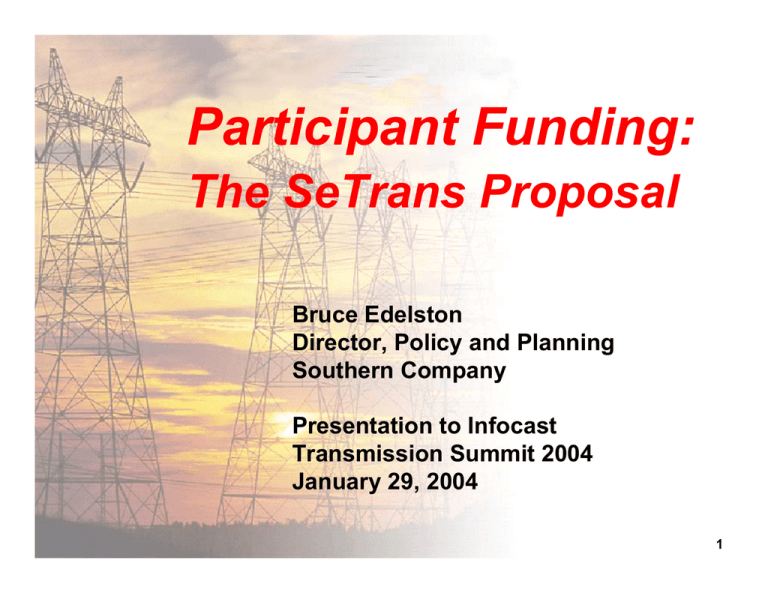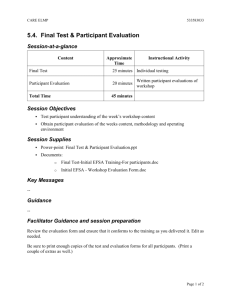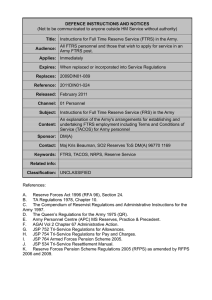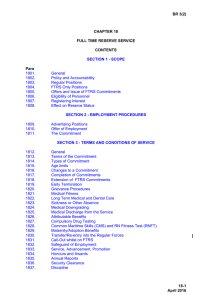Participant Funding: The SeTrans Proposal
advertisement

Participant Funding: The SeTrans Proposal Bruce Edelston Director, Policy and Planning Southern Company Presentation to Infocast Transmission Summit 2004 January 29, 2004 1 SeTrans Participants CLECO Dalton Utilities Entergy Georgia Transmission Corporation JEA MEAG Power City of Tallahassee Sam Rayburn G&T Southern Company 2 SeTrans Region SeTrans 3 Basic Rate Design License Plate rates for all transactions sinking within SeTrans Through and Out rate (“RTOR”) for all transactions sinking outside of SeTrans, designed to collect lost revenues New facilities are either “Base Funded” or “Participant Funded” 4 What is Participant Funding? (as defined by SeTrans) It is a way of funding economic upgrades to the AC network that does not roll their cost into transmission ratebase Under Participant Funding, parties choose to fund upgrades in return for the economic benefits they create: – in the form of new long-term FTRs or other property rights such as qualifying as a network resource – in the form of lower energy prices in delivery constrained areas – in the form of higher energy prices in exportconstrained areas 5 What is Participant Funding? (as defined by SeTrans) (cont.) It is not a method in which a central planner decides what economic upgrades should be built and allocates the costs to those who the planner believes will benefit Rather, it is a method in which market participants decide whether to fund economic investments in transmission, and those who pay for new transmission get the incremental rights created by their investment It ensures that consumers do not have to pay for new investment from which they don’t receive any needed benefit 6 Why Participant Funding? Socializing (rolling in) the costs of upgrades encourages siting of generation that avoids fuel transportation costs In the Southeast, we have significant excess generation that has located near gas fields along the Gulf Coast They can avoid pipeline charges and get “free” electric transmission if costs are rolled in, as per current FERC policy Socialization of transmission costs perpetuates these economically inefficient location decisions 7 Why Participant Funding? (cont.) Socializing costs of new transmission encourages siting of new generation without regard to its effects on congestion: – effectively masks the very price signals that LMP is intended to provide – discourages distributed generation and other alternatives that may be less costly than new transmission – discourages merchant transmission 8 Why Participant Funding? (cont.) Under traditional planning, verticallyintegrated utilities took into account generation and transmission costs when making planning decisions Now, those decisions are being made by different parties Participant funding is the only way of ensuring that all generators face the true (total) costs of their decisions, thus ensuring lowest overall costs of system expansion 9 Basic Definitions Base Funded investments: – investments necessary to maintain standards of safety and reliability and serve forecasted load growth from qualified network resources – investments needed to change-out, replace or repair transmission facilities – investments needed to maintain firm service commitments when the ability to honor commitments is degraded due to circumstances outside the control of the transmission provider (e.g., loop flow or change in reliability standards) 10 Basic Definitions (cont.) Participant Funded investments – everything else, including: ¾investments necessary to interconnect new generators ¾investments necessary to qualify as a new network resource ¾investments necessary for new service ¾investments designed to reduce congestion ¾investments designed to increase transfer capability ¾investments designed to obtain FTRs 11 Simpler Definitions Generally: – Base Funded investments are those that are required to maintain reliability of the system at agreed upon standards – Participant Funded investments are those that are desired by someone to make or save money 12 Cost Recovery in SeTrans Base Funded investments are made by the individual transmission owners, included in their revenue requirements, and rolled into RTO transmission rates 13 Cost Recovery in SeTrans (cont.) Participant Funded investments are made by market participants and are not included in RTO transmission rates Funding parties receive the incremental Financial Transmission Rights (FTRs) created by their investment for 30 years Utilities with retail service obligations are also required to participant fund economic upgrades. Cost recovery is up to state retail jurisdictions. 14 Are FTRs Enough? Some claim that FTRs won’t be sufficient to encourage new investment – for most investments, it is not the FTRs themselves that are valuable -- it’s the right to become a network resource, the ability to get lower delivered energy prices, or the ability to get new firm service – if these benefits aren’t sufficient to incent investment, it’s quite possible that the project is not economic to begin with – the ISA will be responsible for identifying possible economic transmission projects -but not for deciding whether they get built 15 Can We Separate Reliability from Economic Investments? It’s the wrong question – almost all transmission improvements have both reliability and economic benefits What the SeTrans planning process will ask is whether the project is required to meet reliability standards (Base Funded) or optional (Participant Funded) 16 Can We Separate Reliability and Economic Investments? (cont.) If the project is required to meet reliability standards but also has economic benefits, then any economic benefits (including the value of FTRs) created by the project are retained by the same customers that pay for (“fund”) the project (i.e., all customers paying the rolled in cost of the transmission facilities) 17 Can We Separate Reliability and Economic Investments? (cont.) If the project has economic benefits, is Participant Funded, and also has reliability benefits, then such economic benefits also go to the entity (or entities) funding the project However, because the reliability benefits of the project were not needed or required by other customers (and thus not included as a Base Funded investment in the regional plan), other customers should not have to (and do not) pay for the project 18 What Ifs? What if project does not have sufficient benefits for one party but may have sufficient benefits for multiple parties – Merchant transmission developers can put together “syndicates” – Parties can jointly fund projects and allocate FTRs among themselves – ISA will identify such projects for potential beneficiaries 19 What Ifs? (cont.) What if Participant Funded project delays or negates the need for a future reliability investment? – ISA has the discretion to determine the economic value of the delay or cancellation (provided the reliability upgrade is a “certain” part of the regional plan and not just someone’s speculation) and roll in the equivalent costs 20 What Ifs? (cont.) What if a Participant Funded project degrades reliability (creating the need for a new reliability investment), hastens the need for a reliability project, or reduces the FTRs that were created by someone else’s participant funded projects? – Participant Funding party is responsible for the incremental costs created by their investment 21 What Ifs? (cont.) What if there is an argument over whether a facility should be Base Funded or Participant Funded? – issues will be debated when regional plan is being developed – ISA makes final determination as to whether a facility gets Base Funded within the regional plan – parties may use dispute resolution – FERC may be ultimate arbiter 22 Participant Funding Process Transmission owner, ITC, merchant transmission developer, ISA or any market participant identifies an expansion opportunity Transmission owner, with ISA review, estimates cost of project ISA estimates FTRs to be created – or in the case of a request to qualify as a network resource, it will determine the upgrades that are required The funding party signs a cost-based contract for construction of the facility by the transmission owner (or makes arrangements with a merchant developer) Upon completion of the project, incremental FTRs are awarded to funding party 23 Why is Participant Funding Important? Sends the right price signals for efficient generator location decisions Clarifies responsibility for transmission upgrades Avoids having local load shoulder the burden for investments that do not benefit them Facilitates economically efficient grid expansion 24








